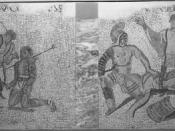Like sporting events in many ancient cultures, Roman gladiatorial combat originated as a religious event. The Romans claimed that their tradition of gladiatorial games was adopted from the Etruscans. The Roman historian Livy wrote about the first known gladiatorial games, held in 310 BCE by the Campanians. These games symbolized the re-enactment of the Campanians' military success over the Samnites, in which they were aided by the Romans.
The first Roman gladiatorial games were held in 246 BCE by Marcus and Decimus Brutus in honor of their father, Junius Brutus, as a funeral gift for the dead. It was a fairly small affair that included the combat of three pairs of slaves in the Forum Boarium, a cattle market. From their religious origins, gladiatorial games grew into important symbols of Roman culture and became a fundamental part of that culture for nearly seven centuries. Eventually gladiatorial games reached spectacular heights in the number of combatants and their monumental venues.
It was traditional to hold gladiatorial games in which 60 duels took place. By 65 BCE, Julius Caesar had upped the ante by pitting 320 ludi, or pairs of gladiators, against one another in a wooden amphitheater constructed exclusively for the event. At this point, gladiatorial games expanded beyond religious events, taking on both political and ludic elements in Rome.
In general, gladiators were condemned criminals, prisoners of war, or slaves bought for the purpose of gladiatorial combat by a lanista, or owner of gladiators. Professional gladiators were free men who volunteered to participate in the games. In the Satyricon, Petronius suggested that Roman crowds preferred combat by free men over that of slaves. For example, the character of Echion is excited about games in which free men, "not a slave in the batch," will fight. Though low on the...

![Villa Borghese gladiator mosaic Español: (obitus)// Iaculator// [------]/ Rodan[---]](https://s.writework.com/uploads/1/15381/villa-borghese-gladiator-mosaic-espanol-obitus-iaculator-rod-thumb.jpg)

Gladiators were paid.
Great essay, very in depth, but professional gladiators didn't only voulenteer, they were usually wealthy and paid alot (sometimes by a place in congress).
0 out of 0 people found this comment useful.